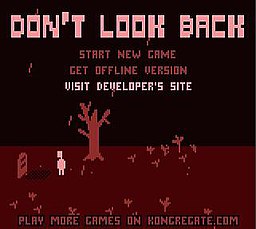Don't Look Back (video game)
| Don't Look Back | |
|---|---|
 | |
| Developer(s) | Distractionware |
| Publisher(s) | Kongregate |
| Designer(s) | Terry Cavanagh |
| Engine | Adobe Flash |
| Release | 2009 |
| Genre(s) | Platform game |
| Mode(s) | Single-player |
Don't Look Back is a platform game playable through Adobe Flash and designed by Terry Cavanagh. The game is a modern interpretation of the Orpheus and Eurydice Greek legend.
The game is a combination of two ideas; Cavanagh wished to create a "silly shooter" where the player's actions were "redeemed" after being shown from a different perspective, he also wished to create a game where the gameplay acted as a metaphor of the player's actions.
Critics praised the game's addictiveness and presentation, but had different opinions over the game's high difficulty level.
Gameplay
The game is an interpretation of the Orpheus and Eurydice legend with stylized graphics resembling those produced by the Atari VCS game console.[1]
Players control a man who begins the game standing at the grave of his lover. After finding a handgun, he descends into the underworld to find the spirit of the deceased and lead her back out to safety.[2] Players have infinite chances to repeat each of the game's screens, the screen must be replayed if the player makes contact with an enemy or hazard, and also if the player turns the man to face his lover once she has been rescued. Play consists of crossing lava pits by jumping across platforms, circumnavigating other hazards, fending off enemies such as spiders and bats, and defeating bosses.[1][3] After safely leading the spirit out of the underworld, the player reaches the gravestone where the game started, to encounter the man still stood at the grave. Both the player character and the spirit disappear, leaving the other figure standing alone at the grave. The journey is a fantasy, once completed the player is confronted by the reality of the figure silently grieving.[4]
Development
Don't Look Back is a combination of two separate ideas, one of which was what Cavanagh termed "a silly shooter or something like that",[4] which would be "redeem(ed)" by a twist which would show the player's actions in a different light. The other idea was creating a game where the gameplay itself was "a metaphor for something else that's happening to the player".[4]
Reception
The iOS port had initially been rejected by Apple due to its marketing material stating that "There are no in-app purchases or any of that nonsense".[5]
Journalists praised Don't Look Back overall, in particular its presentation. Jim Rossignol of Rock, Paper, Shotgun described Don't Look Back as "simplistic, but very tricky",[6] adding "It’s really well done".[6] Indie game developer Derek Yu stated it is a moody game similar to Seiklus but "more focused and challenging",[7] and that it is rewarding to play for fans of the genre.[7] Tim Rose of IndieGames.com said the game is "simply quite brilliant" and "great platforming fun that deserves to be played".[8]
The staff of online video game magazine The Escapist found the game addictive, "a perfect example of doing more with less",[9] and stated it possesses a "wonderfully haunting aesthetic".[9]
In a positive examination of Don't Look Back, game designer Emily Short (writing for Gamasutra) described the game as "not a masterpiece", but she noted that it illustrates "the methods by which a masterpiece will one day be written." She also pointed to the fact that the difficulty of the game elevated it in a way that was impossible for traditional accounts of the Orpheus myth (opera, sculpture, painting, and literature). Through the struggle the player identifies with Orpheus on a much deeper level.[10]
References
- ^ a b Psychotronic (2009-03-05). "Don't Look Back". Jay is Games. Retrieved 2009-06-12.
- ^ Dugan, Patrick (2009-03-20). "Don't Look Back - A Love Story About Jumping Puzzles". Play This Thing. Retrieved 2009-06-12.
- ^ W., Tim (2009-03-01). "Preview: Don't Look Back (Distractionware)". IndieGames.com. Archived from the original on 2009-03-17. Retrieved 2009-06-12.
- ^ a b c Gallaway, Brad (2009-04-18). "Interview with Terry Cavanagh, creator of Don't Look Back". GameCritics.com. Retrieved 2009-06-12.
- ^ http://distractionware.com/blog/2012/10/dont-look-back-now-available-for-ios-and-android/
- ^ a b Rossignol, Jim (2009-03-16). "Don't Look Back". Rock, Paper, Shotgun. Retrieved 2009-06-12.
- ^ a b Yu, Derek (2009-03-13). "Don't Look Back". TIGSource. Retrieved 2009-06-12.
- ^ Rose, Tim (2009-03-05). "Browser Game Pick: Don't Look Back (Terry Cavanagh)". IndieGames.com. Archived from the original on 2010-03-05. Retrieved 2009-06-20.
- ^ a b Escapist Staff (2009-03-13). "Alt + Escape - Don't Look Back". The Escapist. Retrieved 2009-06-25.
- ^ Short, Emily. Analysis: Don't Look Back - Cavanagh's Alternate Game Viewpoints. Gamasutra. 21 July 2009.
